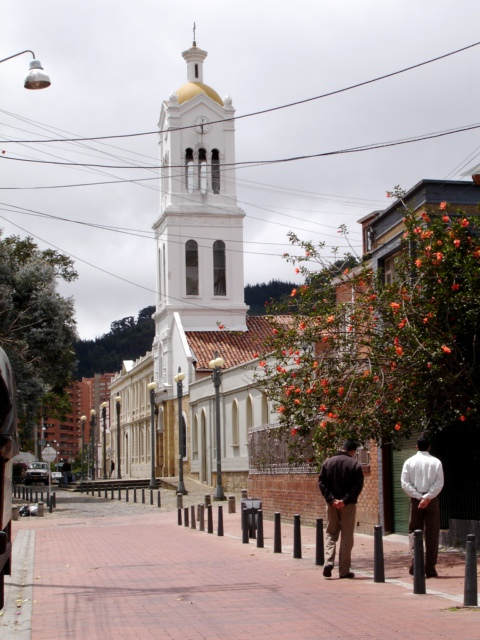|
Calle 127 (TransMilenio)
The simple station Calle 127 is part of the TransMilenio mass-transit system of Bogotá, Colombia, which opened in the year 2000. Location The station is located in northern Bogotá, specifically on Autopista Norte with Calle 125. It serves the Santa Bárbara Occidental and La Calleja neighbourhoods. It is the nearest station to the shopping districts of Avenida Calle 127 (Avenida Rodrigo Lara Bonilla) and Avenida Carrera 19. Many passengers use this station to go to Unicentro, the second-largest mall in the city. History After the opening of the Portal de Usme in early 2001, the Autopista Norte line was opened. This station was added as a northerly expansion of that line, which was completed with the opening of the Portal del Norte later that year. The station is named Calle 127 due to its proximity to that road. Station Services Old trunk services Main line service Feeder routes This station does not have connections to feeder routes. Inter-city service This ... [...More Info...] [...Related Items...] OR: [Wikipedia] [Google] [Baidu] |
Usaquén
Usaquén is the 1st locality of Bogotá, capital of Colombia. It is located in the north of the city. This district is mostly inhabited by upper middle and upper class residents. It is designated as Bogotá's #1 locality, while being a separate municipality of Cundinamarca until 1954, when it was annexed into the city. Today, Usaquén is home to more than 480,000 inhabitants as projected by 2008. The Eastern Hills form the natural border to the east. General information Borders * North: The municipality of Chía * East: The municipality of La Calera * South: The locality of Chapinero * West: The locality of Suba Sites of interest * The colonial quarter of Usaquén includes most of the buildings which belonged to the old municipality of the same name. These buildings are characterized by its Spanish colonial style architecture, similar of those in the La Candelaria neighborhood. Some important buildings in the area include: the Santa Barbara church (constructed in 1665 ... [...More Info...] [...Related Items...] OR: [Wikipedia] [Google] [Baidu] |
Suba (Bogotá)
Suba may refer to: Groups of people *Suba people (Kenya), a people of Kenya **Suba language *Suba people (Tanzania), a people of Tanzania *Subha (writers), alternatively spelt Suba, Indian writer duo Individual people *Suba (musician), Serbian-Brazilian musician *Mihai Suba (born 1947), Romanian chess grandmaster Places * Suba District, a former district of Nyanza Province, Kenya * Suba, Bogotá, a locality of Bogotá ** Avenida Suba (Bogotá), main avenue in the city, named after the locality * Suba, Jerusalem, a Palestinian village near Jerusalem depopulated in 1948 Other * ''Suba'' (film), a 2010 Sri Lankan Sinhala drama film * Okinawa soba See also * *Subah (other) * Subba (other) Subba may refer to: * Ṣubba, the name by which adherents to Mandaeism are known in the Middle East * Limbu people, a Kirati people of Nepal People with the surname * Abhaya Subba, Nepali singer-songwriter and musician * Dinesh Subba (born 196 ... {{disambiguation, geo, ... [...More Info...] [...Related Items...] OR: [Wikipedia] [Google] [Baidu] |
TransMilenio
TransMilenio is a bus rapid transit (BRT) system that serves Bogotá, the capital of Colombia, and Soacha. The system opened to the public in December 2000, covering Caracas Avenue and 80 street. Other lines were added gradually over the next several years, and as of 2022, 12 lines totalling run throughout the city. It is part of the city's Integrated Public Transport System (''Sistema Integrado de Transporte Público'' ITPin Spanish), along with the urban, complementary and special bus services operating on neighbourhoods and main streets. It was inspired by Curitiba's '' Rede Integrada de Transporte'' (Integrated Transportation Network). TransMilenio consists of several interconnected BRT lines, with raised floor stations in the center of a main avenue, or "''troncal''". Passengers typically reach the stations via a bridge over the street. Usually four lanes down the center of the street are dedicated to bus traffic. The outer lanes allow express buses to bypass buses s ... [...More Info...] [...Related Items...] OR: [Wikipedia] [Google] [Baidu] |
Bogotá
Bogotá (, also , , ), officially Bogotá, Distrito Capital, abbreviated Bogotá, D.C., and formerly known as Santa Fe de Bogotá (; ) during the Spanish period and between 1991 and 2000, is the capital city of Colombia, and one of the largest cities in the world. The city is administered as the Capital District, as well as the capital of, though not part of, the surrounding department of Cundinamarca. Bogotá is a territorial entity of the first order, with the same administrative status as the departments of Colombia. It is the political, economic, administrative, and industrial center of the country. Bogotá was founded as the capital of the New Kingdom of Granada on 6 August 1538 by Spanish conquistador Gonzalo Jiménez de Quesada after a harsh expedition into the Andes conquering the Muisca, the indigenous inhabitants of the Altiplano. Santafé (its name after 1540) became the seat of the government of the Spanish Royal Audiencia of the New Kingdom of Granada (creat ... [...More Info...] [...Related Items...] OR: [Wikipedia] [Google] [Baidu] |
Colombia
Colombia (, ; ), officially the Republic of Colombia, is a country in South America with insular regions in North America—near Nicaragua's Caribbean coast—as well as in the Pacific Ocean. The Colombian mainland is bordered by the Caribbean Sea to the north, Venezuela to the east and northeast, Brazil to the southeast, Ecuador and Peru to the south and southwest, the Pacific Ocean to the west, and Panama to the northwest. Colombia is divided into 32 departments and the Capital District of Bogotá, the country's largest city. It covers an area of 1,141,748 square kilometers (440,831 sq mi), and has a population of 52 million. Colombia's cultural heritage—including language, religion, cuisine, and art—reflects its history as a Spanish colony, fusing cultural elements brought by immigration from Europe and the Middle East, with those brought by enslaved Africans, as well as with those of the various Amerindian civilizations that predate colonization. S ... [...More Info...] [...Related Items...] OR: [Wikipedia] [Google] [Baidu] |
Autopista Norte (Bogotá)
Autopista Norte, also called Autopista paseo de los libertadores (Way of the Liberators Highway), is a major road in Bogotá, Colombia, running through the northern part of the city to its southern end at Avenida Caracas. Names The road was opened in 1956 and was named Autopista Norte until Calle 100. From that point north, it was known as Autopista paseo de los libertadores until the city of Tunja. Some time later, the name Autopista Norte came to mean the stretch of the road from its southerly beginning until Calle 194. Due to changes in nomenclature and the urban expansion of the city to the north, the name was changed to ''Avenida 13'' and was changed again in 2006 to Avenida Carrera 45. Route The road begins in the Los Héroes monument between the Barrios Unidos and Chapinero localities and continues north. In its median is a line of the TransMilenio mass-transit system to Portal del Norte on Calle 170. It continues north to La Caro in Chia. Between 180th and 192 ... [...More Info...] [...Related Items...] OR: [Wikipedia] [Google] [Baidu] |
Portal De Usme (TransMilenio)
Portal de Usme is one of the terminal stations in the TransMilenio mass-transit system of Bogotá, Colombia, opened in the year 2000. Location Portal de Usme is located in the extreme south of Bogotá, specifically on Avenida Caracas south of the La Picota national penitentiary. History In 2001, a few months after the opening of the system, the Portal de Usme was opened as the second terminal station in the system. After a lawsuit from a passenger complaining of lack of handicapped access on the feeder routes at the station, the fleet of feeder buses was renovated to accommodate this service in 2005. On February 2, 2002, police thwarted an attempt to use dynamite against the station by disarming six sticks of the explosive. Station services Old trunk services Current trunk services Feeder routes The terminal operates the following feeder routes: * Santa Librada loop * Chuniza loop * Alfonso López loop * Usminia loop * Danubio loop * Virrey loop * Marichuela ... [...More Info...] [...Related Items...] OR: [Wikipedia] [Google] [Baidu] |
Portal Del Norte (TransMilenio)
Portal del Norte is one of the terminus stations of the TransMilenio mass-transit system of Bogotá, Colombia, which opened in the year 2000. Location Portal del Norte is located in northern Bogotá, specifically on Autopista Norte with Calle 175. It serves the La Uribe, Villa del Prado, Nueva Zelandia, and Northwest San Antonio neighborhoods. History In late 2001, after the opening of the Portal de Usme, the Portal del Norte was opened as the third terminus in the system. Nearby there are Éxito and Home Center superstores, as well as a Colsubsidio and a small shopping center called Panama. In mid-2005, its entire fleet of feeder buses made by Mercedes Benz and operated by ''Alnorte'' were renovated to be put into non-TransMilenio service. A new operator, ''Alnorte Fase 2'' began service with new Volkswagen buses that bore the branding of Brazil's Busscar. Station services Old trunk services Main line service Feeding services The following feeder routes also wo ... [...More Info...] [...Related Items...] OR: [Wikipedia] [Google] [Baidu] |
E100
E100 or E-100 may refer to: Electronics * Casio Cassiopeia E-100, a pocket of knife PC * iriver E100, a portable media player Vehicles Automobiles * Baojun E100, a Chinese electric microcar * JMEV E100, a Chinese electric city car * Toyota Corolla (E100), a Japanese compact car lineup Military vehicles * Panzerkampfwagen E-100, a proposed German World War II super-heavy tank Other uses * Curcumin Curcumin is a bright yellow chemical produced by plants of the ''Curcuma longa'' species. It is the principal curcuminoid of turmeric (''Curcuma longa''), a member of the ginger family, Zingiberaceae. It is sold as a herbal supplement, cosmet ..., food coloring from turmeric designated by E number ''E100'' * Neat ethanol fuel, or E100, a fuel blend with almost 100% ethanol {{Letter-Number Combination Disambiguation ... [...More Info...] [...Related Items...] OR: [Wikipedia] [Google] [Baidu] |
E150
Caramel color or caramel coloring is a water-soluble food coloring. It is made by heat treatment of carbohydrates (sugars), in general in the presence of acids, alkalis, or salts, in a process called caramelization. It is more fully oxidized than caramel candy, and has an odor of burnt sugar and a somewhat bitter taste. Its color ranges from pale yellow to amber to dark brown. Caramel color is one of the oldest and most widely used food colorings for enhancing naturally occurring colors, correcting natural variations in color, and replacing color that is lost to light degradation during food processing and storage. The use of caramel color as a food additive in the brewing industry in the 19th century is the first recorded instance of it being manufactured and used on a wide scale. Today, caramel color is found in many commercially produced foods and beverages, including batters, beer, brown bread, buns, chocolate, cookies, cough drops, spirits and liquor such as brandy, rum, ... [...More Info...] [...Related Items...] OR: [Wikipedia] [Google] [Baidu] |





